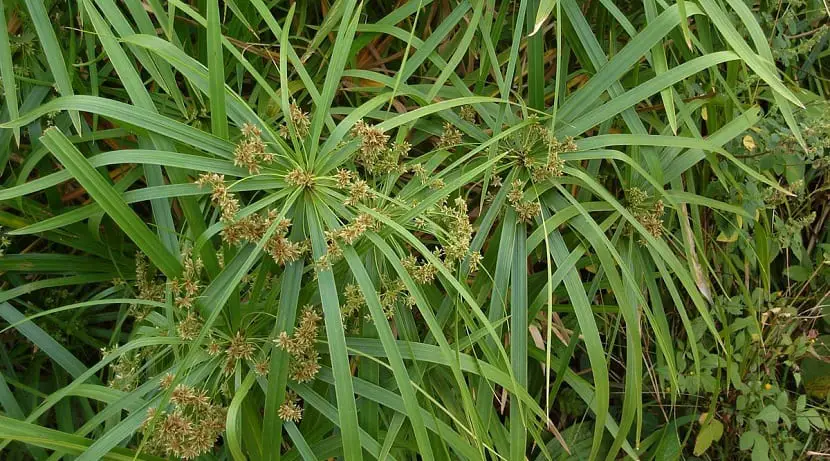
Today I am going to talk to you about a genus of herbaceous plants belonging to the sedge family that comes in handy for our garden or our patio. It can also serve as a decoration for tables and large furniture.
It is about the genus Cyperus. Do you want to know how to take care of cyperus and what characteristics it has for our garden?
A genus of cypress

The genus cyperus is composed for about 700 species that are distributed by all the continents. They are capable of developing both in tropical regions and in temperate regions. They are annual or perennial plants that can monopolize certain environments due to their high reproductive capacity. Among the 700 species that exist, they vary greatly in size that can vary from 5 cm to 5 meters. The stems can be circular, with transverse cuts in some, triangular in others and usually with a fairly long internode, which makes basal and apical leaves visible. The flowers are greenish and are born clustered between the apical leaves. The seed is a small grain that is spread by the wind for pollination
Characteristics of the cyperus
As I have mentioned before, cyperus are perennial herbaceous plants, with stems of triangular section. At the end of the plant they carry an umbel of oblong-lanceolate leaves with a cartilaginous consistency. Its flowers are not very interesting, although they are good for gardens. In the natural environment its habitat is the margins of rivers and water courses, so it is used in gardening to accompany ponds. Although it is also used in interior decoration as we will see later.
Cyperus care

As for their needs, they need open air and sun or semi-shade, so if we want to plant it inside the house, it must be kept in a position where it is quite illuminated, but that does not give it the sun directly. . It prefers warm areas where winters are not very extreme. The ideal temperature so that it does not affect it negatively must be above 8 degrees. In winter it must be protected from sudden changes in temperature since they can yellow and wilt. To avoid this, in situations of great temperature shocks, it is better to put them inside.
For irrigation it is better to keep it in the open air rooted in the bottom of ponds and small lakes. Indoors, it should be frequent watering or immersing the pots in containers that contain water.
As for its indoor cultivation, it does not present any problem that requires special care or attention or high need for irrigation. Thanks to their enormous perspiration rate, cyperus are ideal for humidifying the home environment.
They must be paid once a month during the spring-summer months, which is when they are growing. The advantage of these plants is that they do not contract any type of plague. Cyperus need more severe pruning if they have suffered a sudden change in temperature in which we have to leave them without leaves. This way we can protect it. It should also be pruned in late winter every two years. If you are going to plant it at home, you have to take into account that they grow very fast and will need a larger pot very quickly.
Cyperus papyrus

It is a species of this genus that grows in areas ranging from Egypt to tropical Africa. It was used by the Egyptians to make writing sheets. As for its altitude, it can be between 3 and 4 meters high. The stem has no leaves and its base can be 8 cm. The inflorescences are formed by feathery spikelets that appear from July to September.
Cyperus alternifolius

It is a species of the genus Cyperus that is native to Madagascar. It is a perennial species and of this genus it is the most widespread species. As their measurement does not exceed one meter in height and the flowers are grouped in spike-shaped inflorescences that bloom in summer. It is a species that adapts well to growing on floors and is very lush.
